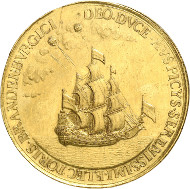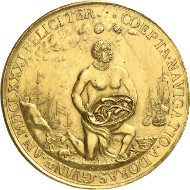
PREV ARTICLE
NEXT ARTICLE
FULL ISSUE
PREV FULL ISSUE
1681 GUINEA SLAVE TRADE MEDAL OF FREDERICK WILLIAM
The Article of the Week in the October 29, 2015 issue of CoinsWeekly offers an interesting view into the 18th century African
slave trade. Here's a short excerpt; be sure to read the complete article online. The medal was sold yesterday (October 30) by the
Künker auction house (lot 227). -Editor
 
At the beginning of the year 1681, the small expedition reached the Guinean coast. They were welcomed by native tradesmen with great friendliness. This was due to the fact that the lucrative slave trade was strictly separated into two different businesses: Native traders took captives in the mainland and sold them to Western tradesmen, who in turn took responsibility for the transport over the Atlantic, on the coast. Accordingly, it was in the interest of those native traders that as many different buyers as possible were in competition with each other and thus kept up the prices. Against this background, Brandenburg was nothing but a new customer and welcomed with open arms. Of course the competition, the Dutch trading company, showed a very different reaction. An aggressive exchange of letters between the company and the elector ensued, in which the Dutch insisted that trade with Guinea remain their sole right. And when the elector argued with that, they did not hesitate long but captured one of the two ships sailing along the Guinean coast under the Brandenburg flag. The other ship was more fortunate. It returned home with 100 pounds of gold and 10,000 pounds of ivory as well as a contract with three local rulers on board. The contract obliged Brandenburg to build a fort as a trading post. The locals were willing to support the construction and asked for a Brandenburg flag to show off their alliance visible for other traders. This treaty led to the founding of Fort Groß Friedrichsburg and of the Brandenburg African Company. The gold that the expedition had brought back was minted into medals on behalf of Frederick William. Their obverse shows a ship – probably the returned Morian – accompanied by a Latin circumscription (in translation): Under the guidance of God and the auspices of his Highness the Elector of Brandenburg. The reverse is dedicated to the real matter of the expedition: We see a slave against a coastal landscape, offering grains of gold and ivory tusks on a large platter. Several trade ships are visible in the background. The circumscription reads (in translation): The voyage to the coasts of Guinea fortunately embarked on in the year 1681. On behalf of the elector, the medal continued to be minted in Emden, the home port of the Brandenburg African Company, later on. And the Deo Duce – under the guidance of God – is also repeated on the later Guinea ducats, minted at the Berlin mint. To read the complete article, see:

Wayne Homren, Editor The Numismatic Bibliomania Society is a non-profit organization promoting numismatic literature. See our web site at coinbooks.org. To submit items for publication in The E-Sylum, write to the Editor at this address: whomren@gmail.com To subscribe go to: https://my.binhost.com/lists/listinfo/esylum All Rights Reserved. NBS Home Page Contact the NBS webmaster 
|